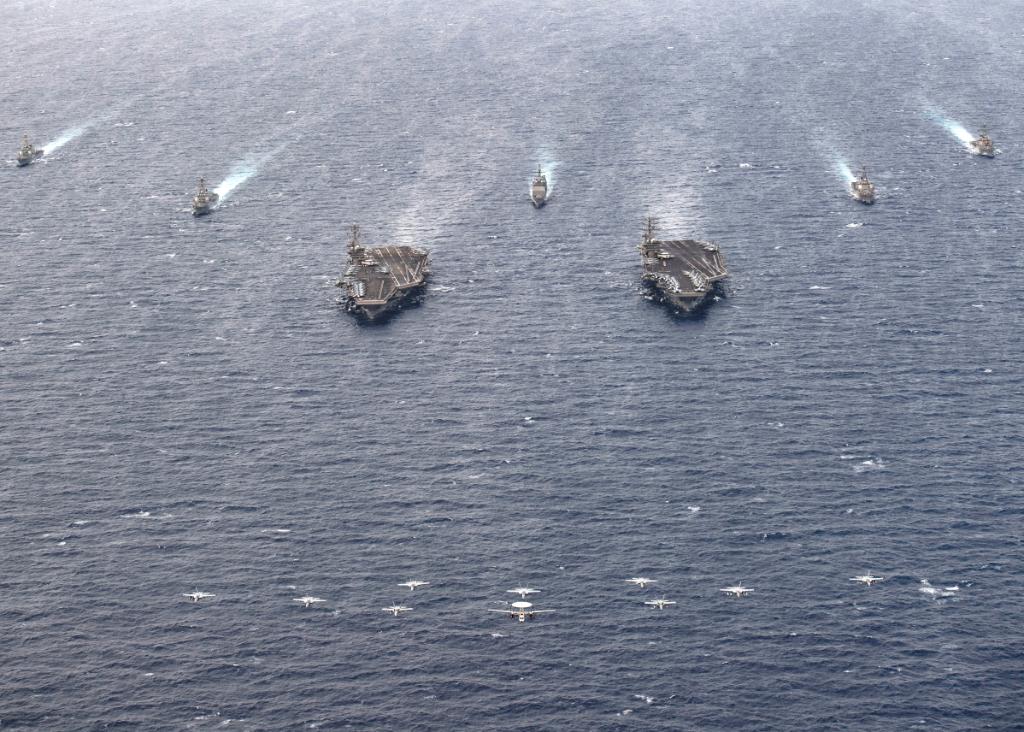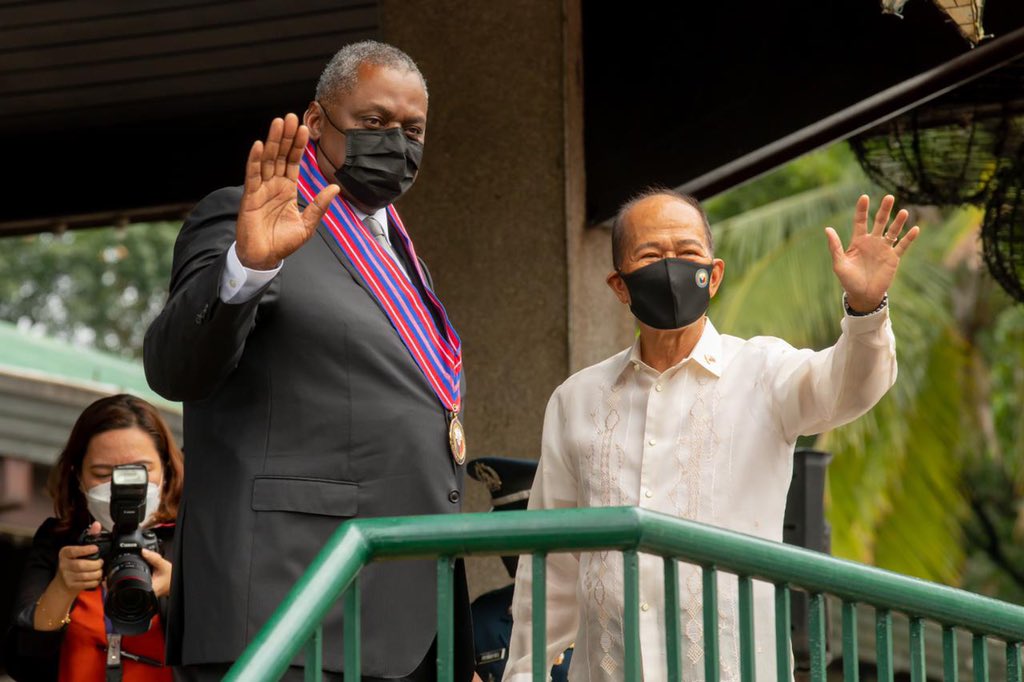Some analysts say that “the US’s ignominious exit from Afghanistan reflects the failure of American’s foreign policy establishment at both prediction and policy making(link is external)”. If so, it is not the first time, nor will it be the last. Indeed, another American foreign policy failure may be in the offing—this time regarding America’s involvement in the South China Sea situation.
The U.S. is striving to enlist the support of Southeast Asian countries in its efforts to contain and constrain China. One way it is doing this is to support them in their maritime disputes with China(link is external). However, this strategy is based on false assumptions and wishful thinking.
A prime false assumption is that “in much of Southeast Asia, particularly the Philippines and Vietnam, elites and the broader public judge Washington’s commitment to the region based in part on whether it defends their maritime rights.” The Philippines and Vietnam are forefront countries in these disputes with China. But they are not “much of Southeast Asia”. Besides these two, only Brunei, Malaysia and Indonesia have maritime claims in the South China Sea and they are wary of US military involvement(link is external) in the issues. Those Southeast Asian nations that are directly involved or affected by US involvement in the issues judge it in terms of its contribution to furthering their interests –not broadering US strategic interests.
The US cannot match China’s economic prowess and largesse(link is external) and hopes that its political, social and economic systems, and its values, will be sufficient to keep much of Southeast Asia in its camp. However, policy makers are increasingly unsure if these are sufficient. Indeed, the U.S. is beginning to realize that from Southeast Asians’ perspective “the difference between the two hegemons is generally one of degree rather than of kind(link is external).” So the U.S. is falling back on its dominant military power(link is external) and the threat to use it.

Theodore Roosevelt and Nimitz CSGs conducted dual carrier operation in the South China Sea, Feb 9. Photo: US Navy
Yet the current US approach continues to put the military cart before the diplomatic horse and will only beget a tit-for-tat response from China. This increases militarization on both sides and worries Southeast Asian countries(link is external) that would suffer from collateral damage in any conflict.
The U.S. claims that its stepped up military presence is to prevent China from bullying its rival claimants. American forces will “stand with regional friends and partners to resist coercion(link is external).” The U.S. is using these disputes as an excuse for increasing its military presence in the hope that it will encourage them to ‘stand up’ to China and thus draw some Southeast Asian states to its side. But no Southeast Asian country wants a military clash between China and the U.S.
Indeed, Indonesian policymakers remain suspicious of US motives and worry about the potential destabilizing effect of US-China competition. They want Washington to exercise restraint. Then Indonesian Defense Minister Ryamizard Ryacudu suggested(link is external) that “if regional countries can manage the SCS on their own, there is no need to involve others.” Luhut Pandjaitan, then coordinating minister for political, legal and security affairs, declared(link is external) in a veiled criticism of both US and China “… we don’t like any power projection.”
Malaysia has also been uncharacteristically blunt. Its then Foreign Minister Hishammuddin Hussein called for the big powers “to avoid military posturing.” He said Malaysia must avoid being “dragged and trapped” in a political tug of war between superpowers. He also expressed serious concern that the US-China struggle would split ASEAN.
Philippine President Rodrigo Duterte has publicly stated that the Philippines will form policies regarding China that are in the Philippines best interests(link is external)—not necessarily those of others including those of the U.S.
Some Southeast Asian countries have tried to take advantage of this contest by hedging and thus benefiting from the largesse of both –China’s economic strength and the US’s security blanket. But this is proving to be an increasingly dangerous game as the two competitors crank up the pressure to choose sides. If there is resistance by Southeast Asian countries to the ‘entreaties’ of the contesting powers, neither is beyond angry threats, military intimidation and formal or informal sanctions to get their way. A particular concern is that the intensifying competition for influence and military dominance in the region could spill over into their domestic politics with the U.S. and China each aiding its supporters and opposing its opponents. This happened during the Cold War between the U.S. and the Soviet Union and it could happen again.
But in the face of—or perhaps because of these realities—in late August, US Vice President Kamala Harris traveled to Singapore and Vietnam to bolster the continuing effort to bring Southeast Asian countries into a US-led coalition against China. Her visit followed one in late July by US Secretary of Defense Lloyd Austin that was designed to do much of the same. In Singapore she declared(link is external) that “the United States stands with our allies and partners in the face of [China’s] threat in the South China Sea”. In her meeting with Vietnam’s President Nguyen Xuan Phuc Harris said “We need to find ways to pressure, raise the pressure…on Beijing to abide by the United Nations Convention on the Law of the Sea, and to challenge, its bullying and excessive maritime claims.” Specifically she offered material and training assistance(link is external) to enhance its maritime security capacity as well as more visits by US warships.
But just before her visit Vietnam’s Prime Minister Pham Minh Chin told China’s ambassador to Vietnam that Vietnam does not take sides in foreign policy.(link is external) This was a warning sign that the U.S. should not place too much hope in winning over Vietnam in its attempt to build a coalition against China.
Vietnam’s leaders well know that China will always be ‘there’—an unpredictable giant on its northern and maritime borders—while the U.S. presence in the region is comparatively fickle and fleeting. Moreover, Vietnam is steadfastly non-aligned. Indeed, its long-standing policy is the “three nos(link is external)”—no participation in military alliances, no foreign military bases on Vietnamese territory, and no reliance on one country to fight against another. Despite US hopes, that is not likely to change in the near future.
Despite such warning signs, others have jumped on this policy bandwagon. They argue that there is now “an opportunity to revitalize US policy in the South China Sea”.(link is external) They suggest that “the Biden administration seizes upon this ‘breakthrough’ [the extension of the Visiting Forces Agreement-VFA-with the Philippines] to lay the foundations for an international coalition that supports a rules-based maritime order.” They suggest that “the US and Philippines defense establishments lay the groundwork to rapidly implement the Enhanced Defense Cooperation Agreement under Duterte’s successor.” To them this includes the deployment of US missiles in the Philippines which would threaten China’s assets in the South China Sea and thus make it a Chinese target in the event of a US-China conflict.

The Philippines and the US decided to fully restore the Visiting Forces Agreement, July 30, 2021. Photo: US DoD
Some hope that the successor to nationalist Philippine President Rodrigo Duterte in next year’s elections will take the lead against China and support US military involvement in the issues. But it is not clear that Duterte’s successor will make Filipinos’ security subservient to the interests of America. Those hoping for a more pro-American Philippine President are viewing Philippine domestic politics through the lens of its Americanophiles and seem blind to the uncomfortable fact that despite opposition to Duterte’s China policy, he and his nationalism remain very popular with the masses. In any event, Philippine support for US involvement is fickle.
In addition to these impediments to a US-led anti-China coalition, the claimants—especially the forefront states Vietnam and the Philippines—cannot unite on these issues. No regional country wants to take the lead and most are unwilling to stand up to China. Indeed, as some proponents of this strategy acknowledge, “there are limits to how aggressive Southeast Asians can be.(link is external) They are too economically exposed to China and lack the geopolitical heft to impose serious costs on Beijing”. Indeed, this is so. But as they also say, the U.S. “and like-minded countries cannot alter China’s behavior at sea without the active participation of these regional claimants.” Moreover, US interests are constantly changing and promises of US support are unreliable. Indeed, the debacles in Vietnam and now Afghanistan attest to this fact.(link is external)
Several European nations have displayed military force in the South China Sea. But are any of these countries is willing to put their assets in real harm’s way to support continued US hegemony? And how would the U.S. react to a kinetic conflict between a politically—and militarily—more vulnerable European military asset?
For those who advocate policies that risk military confrontation with China in the South China Sea, the basic question they need to answer is “Is it worth American blood and treasure to defend the Philippines’ claim to disputed rocks there”? In the wake of Vietnam and now Afghanistan, this is going to be a hard sell domestically. And in the end, for the U.S., the people are the final arbiter.
To better understand the political risks of the current US approach, let’s look at several scenarios based on a continuation of current US policy.
One scenario that is not farfetched is one in which an element of the Philippines military provokes a clash with China’s military and the Philippines demands the U.S. honor its commitment to come to its defense. The U.S. hems and haws and invokes the procedural provisions in their Mutual Defense Treaty(link is external).
A variation of this scenario is one in which the U.S. does provide immediate military support. But China ups the military ante. The Philippines cuts and runs—both militarily and politically—leaving the U.S. to clean up the military and political mess with China and probably resulting in a US climb down. In another variation of this scenario, China compromises with the other claimants leaving the U.S. looking like the aggressor.
In any of these scenarios, US credibility would be shot.
Another scenario is continuance of the current situation. The U.S. continues to build up its military power in the region only to have the very countries it is supposedly defending ask it to lighten up or even stand down. They all have their own reasons why they might do so, but common ones are their economic dependence on China and the fact that it is a permanent part of the region that they will have to live with, long after the U.S. has left.
Another problem that is deeper than the U.S. establishment thinks is its mantra of a Free and Open Indo-Pacific and what it calls Freedom of Navigation Operations (FONOPs) as a cover for its campaign to contain China. The U.S—alone among major powers—has not ratified the UN Convention on the Law of the Sea that is supposed to guide nations’ behavior as the foundation of a “rules-based maritime order”. Yet it often conducts FONOPs against these states as well as against China. This not only risks military confrontation with China, but puts off the maritime Southeast Asian nations that it wants to win to its side.
From their perspective this US-China contest for dominance has ushered in a new neocolonial era. Although the methods of “colonialism” have changed, the fundamental intent of subjugating them to the national interests of outside powers has not. Now instead of physical conquest and occupation, China and the U.S. are trying to impose on them their respective economic and ideational norms and values.
These states realize that the U.S. is trying to use them in its effort to contain China militarily and politically. They know that their long-term interests are not the U.S.’s concern and that the U.S. will back them only so long as it is in its interests to do so. Thus, they are desperately trying to avoid the more likely scenario—a division and polarization of the region. This would mean the emasculation—if not the death of ASEAN, exacerbation of historical animosities and foreign influence and involvement in their already volatile domestic politics. To Southeast Asians the only beneficiaries of this “cold war” geopolitics would be the foreign powers and they would once again have become pawns in a ‘great game.’
What to do? According to Zack Cooper and Adam P. Liff writing in Foreign Affairs(link is external) “the Biden administration must develop and execute a positive comprehensive strategy for Asia with the hard lessons from the past in mind”. Yes indeed. But what should it look like?
The foundation for a policy that can avoid failure is simple. Consider and make policy with the short term and long-term interests of Southeast Asians on a par with those of the U.S. If the approaches and agreements are truly in each other’s interests and voluntarily entered, then relations would greatly improve. In the long-term soft power produces much stronger international bonds than hard power.
In a sop to worried Southeast Asian leaders, Harris has proclaimed that the U. S. is not trying to “make anyone choose between countries”. But that is exactly how they view the U.S.’s offers of military ‘cooperation’, requests to place assets on their soil, and its diplomatic offensive. Instead of pushing them to choose and thus generating more pressure from China, the U.S. should use its best weapon—its culture. Although obviously somewhat tarnished, it currently is the winning hand. If the U.S. truly believes that its system is best for these countries, let it work its magic rather than shove it and US strategic interests down their throats.
You might ask what this would look like in detail. It would be much more politically effective to base its military strategy on defensive over the horizon capabilities. Surely there must be a way to demonstrate US military defensive capability without forcing Southeast Asian countries to accept US military occupation. No country, no people, likes or wants foreign boots on its soil indefinitely. This makes them appear to be a political puppet of the occupier and an automatic target in a conflict. Even if the government is persuaded to allow it, the people will eventually reject it. If one thinks this is unlikely remember that the Philippines threw the US military out once(link is external) and could easily do so again.
Regarding the South China Sea, the US should cease trying to push the claimants with disputes with China into ‘standing up’ to it. They will if they want, and if they do, they will do it in their own way. That may not appeal to the militarists. But acceptance of this reality would help smooth relations.
The U.S. needs to rebuild in Southeast Asian countries the confidence that it respects them and their interests and that it can and will handle its differences with China competently and peacefully. For Southeast Asia as a whole, half the battle is just showing up. US President Donald Trump did not. President Joe Biden needs to attend ASEAN summits; listen carefully; and offer wherever he can what they want –not what the U.S. wants or thinks will preferentially benefit it. This will show respect and give face to the ASEAN leaders—again something sorely missing in the arrogant America First approach of the Trump administration—and even in the so-far America First lite of the Biden administration. The U.S. should also offer more institutionalized economic co-operation by joining the RCEP(link is external) or a version of it.
The Biden administration should reexamine the costs and benefits of its Freedom of Navigation Operations to determine if continuing them and especially repeating particular ones are really worth the risk of confrontation and conflict with China and the resentment they generate in Southeast Asian countries. After all, diplomatic protest is sufficient to establish the US position rather than resorting to gunboats.
The U.S. also needs to abandon its disingenuousness that conflates commercial freedom of navigation—which China is not threatening—from freedom of navigation for warships and warplanes. Most see through this ruse and it does not match the US rhetoric of transparency and altruism. It needs to address the fact that it is not a party to UNCLOS and that there are different interpretations of “freedom of navigation” and what violates it. This would set the stage for negotiating its meaning and appropriate responses to violations thereof and then incorporating that understanding in the agreed Code for Unplanned Encounters at Sea.
More important, it needs to lighten up on its messianic human rights crusade. It is one thing to state its principles and preferences. But it is another to try to force these values on others. That is resented and rejected by Southeast Asian countries that do not view ‘human rights’ in the same light. Violations of human rights in these countries are real and deplorable. But any actions should be taken by and through international bodies like the UN, the International Criminal Court and the UN Commission on Human Rights. The U.S. would gain more soft power if it were less arrogant in criticism of human rights violations, and did not use of them as a political tool.
Regarding the South China Sea disputes, the best that can be done is to manage them so as to prevent an outbreak of open kinetic conflict. Although there have been incidents over the years, the disputants have been successful in doing so. The more outside powers like the U.S. get militarily involved, the more likely the disputes will spin out of control—to the detriment of Southeast Asia. US policy makers should beware of recommendations for US involvement in the South China Sea disputes based on questionable assumptions and wishful thinking. Doing so may help avoid another US foreign policy failure.

